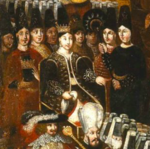Osman II
Osman II (Istanbul, November 3, 1604 — Istanbul, May 20, 1622) was a sultan of the Ottoman Empire who reigned from 1618 until his death.
Biography
Osman was the first son of Ahmed I (1590-1617) (r.1603-1617), and his consort Mahfiruz Hatice Hatun (1590-1620). He came to the throne at the young age of fourteen as a result of a coup d'état against his uncle Mustafa I, which is believed to have been provoked by the mother of his half-brothers Kösem Sultan. On December 24, 1619, he appointed Admiral Çelebi Ali Pasha as grand vizier, an act that marked the adoption of an expansionist foreign policy and the imposition of an absolutist mode of government dominated by the court that lasted the rest of the reign. The admiral had served a relevant role in the overthrow of Mustafa in February of the previous year. Immediately, the sultan decided to declare war on Poland-Lithuania.
Despite his youth, Osman soon sought to consolidate his power as sovereign, then limited by powerful court figures and certain relatives, through a great military victory and decided to personally lead the Ottoman invasion of Poland during the Wars of the Ottoman Empire. Magnates of Moldavia, despite the fact that much of the Government tried to dissuade him. He was resoundingly defeated at the Battle of Khotyn in September and October 1621 (actually the siege of Khotyn, begun in January) by the hetman (second commander in chief after the Polish monarch Jan Karol Chodkiewicz. Osman II returned to Constantinople humiliated (January 9, 1622), blaming the cowardice of the janissaries for his disgrace on the battlefield.
Probably the first sultan to identify and envision the janissary corps as a praetorian institution that harmed rather than benefited the modern Empire, Osman attempted to reorganize and limit its powers by closing its coffee halls (the meeting points for plotting against the throne) and moved loyal troops to the capital. He was preparing to carry out a new campaign in the Levant, probably to recruit mercenaries who would be loyal to him and thereby reduce the power of the Army when on May 19 the soldiers overthrew him and returned the throne to his uncle Mustafa. The palace mutiny would have occurred. It was encouraged by Halime Sultan, the mother of Mustafa I. Osman was captured, tortured and murdered the day after losing power. It was the first regicide in the history of the Ottoman Empire.
Osman was surely an impetuous young sultan, known for being vengeful and sometimes sadistic. His dreamy ideals such as making Bursa capital, eliminating the army, reinstating fratricide, conquering Vienna, were what led to his abrupt end.
Consorts
- Haseki Ayşe Sultan (1603 — 1640), was his first consort and mother of Şehzade Ömer. She was the daughter of astrologer Ahmed Efendi. Ayşe was a granddaughter of Pertev Paşa, and a granddaughter of Hatice Sultan, the sister of Solián the Magnificent. He was the only wife to receive the title of Haseki Sultan, yet he was considered a politically insignificant wife. They were married in 1619;
- Akile Rukiyye Hanım (1607 – 1630), was one of the most commented marriages in Ottoman history, since she was the daughter of the Şeyhülislam Hocazade Esad Efendi, so Osman broke rules by marrying her. They were married on 7 February 1622 and had two children born after the execution of Osman;
- Meylişah Hatun (1608 — 1631), his name appeared in January 1622 as a new concubine without children. Others mention it as Meleksima or Meylikaya. Sometimes she is confused as a mother of Şehzade Ömer.
Offspring
Children
- Şehzade Ömer (20 October 1621 — January 1622), son with Ayşe. He died while they celebrated a victory. The prince was present in these games and by a sudden shooting of an ark killed him. Others say that the shock from such heavy shots died;
- Şehzade Mustafa (November 1622— c.1623), son with Akile, died young;
Daughter
- Zeynep Sultan (November 1622— c.1624), daughter with Akile. The privy purse indicates his name during the first year of his uncle's reign, Murad IV. The same year ceases to be mentioned between October and November, indicating that he died between those dates.
Contenido relacionado
Azerbaijan
Operation Barbarossa
Annex: Municipalities of Michoacán
Soviet Union
Andalusia

